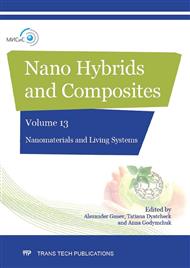[1]
Zhang F, Ren T, Wu J Niu J. Small concentrations of TGF-β1 promote proliferation of bone marrow-derived mesenchymal stem cells via activation of Wnt/β-catenin pathway. Indian J Exp Biol. 53(8) (2015) 508-13.
Google Scholar
[2]
Muller F. L., at all, Trends in oxidative aging theories. Free Radic. Biol. Med. 43(2007) 477.
Google Scholar
[3]
Valle-Prieto A., P. A. Conget, Human mesenchymal stem cells efficiently manage oxidative stress, Stem Cells and Development, 19(12) (2010) 1885–1893.
DOI: 10.1089/scd.2010.0093
Google Scholar
[4]
Li T. -S., E. Marb´an, Physiological levels of reactive oxygen species are required to maintain genomic stability in stem cells, Stem Cells, 28(7) (2010) 1178–1185.
DOI: 10.1002/stem.438
Google Scholar
[5]
Higuchi M., G. J. Dusting, H. Peshavariya et al., Differentiation of human adipose-derived stem cells into fat involves reactive oxygen species and forkhead box o1 mediated upregulation of antioxidant enzymes, Stem Cells and Development, 22(6) (2013).
DOI: 10.1089/scd.2012.0306
Google Scholar
[6]
Perales-Clemente E., C. D. Folmes, A. Terzic, Metabolic regulation of redox status in stem cells, Antioxidants & Redox Signaling, 21(11) (2014) 1648–1659.
DOI: 10.1089/ars.2014.6000
Google Scholar
[7]
Mathieu J., W. Zhou, Y. Xing et al., Hypoxia-inducible factors have distinct and stage-specific roles during reprogramming of human cells to pluripotency, Cell Stem Cell, 14 (5) (2014) 592–605.
DOI: 10.1016/j.stem.2014.02.012
Google Scholar
[8]
Walkey C, Das S, Seal S, Erlichman J, Heckman K, Ghibelli L, Traversa E, McGinnis JF, Self WT. Catalytic Properties and Biomedical Applications of Cerium Oxide Nanoparticles. Environ Sci Nano. 1; 2(1) (2015) 33-53.
DOI: 10.1039/c4en00138a
Google Scholar
[9]
Lee SS, Song W, Cho M, Puppala HL, Nguyen P, Zhu H, Segatori L, Colvin VL. Antioxidant properties of cerium oxide nanocrystals as a function of nanocrystal diameter and surface coating. ACS Nano. 26; 7(11) (2013) 9693-703.
DOI: 10.1021/nn4026806
Google Scholar
[10]
Baker C.H. Cerium oxide nanoparticles protect gastrointestinal epithelium from radiation-induced damage by reduction of reactive oxygen species and upregulation of superoxide dismutase 2. Nanomedicine 6 (2010) 698-705.
DOI: 10.1016/j.nano.2010.01.010
Google Scholar
[11]
Dowding M., Talib Dosani, Amit Kumar, Sudipta Seal and William T. Self Cerium oxide nanoparticles scavenge nitric oxide radical (˙NO) Chem. Commun., 48 (2012) 4896-4898.
DOI: 10.1039/c2cc30485f
Google Scholar
[12]
Shcherbakov A.B., N.M. Zholobak, A.E. Baranchikov, A.V. Ryabova, V.K. Ivanov. Cerium fluoride nanoparticles protect cells against oxidative stress Mater Sci Eng C Mater Biol Appl. 50 (2015) 151-9.
DOI: 10.1016/j.msec.2015.01.094
Google Scholar
[13]
Ying Xue, Qingfen Luan, Dan Yang, Xin Yao , and Kebin Zhou J. Direct Evidence for Hydroxyl Radical Scavenging Activity of Cerium Oxide Nanoparticles, Phys. Chem. C, 115 (11) (2011) 4433–4438.
DOI: 10.1021/jp109819u
Google Scholar
[14]
Ivanov V.K., Shcherbakov A.B., Usatenko A.V. Structure-sensitive properties and biomedical applications of nanodispersed cerium dioxide / Russ. Chem. Rev. 78 (2009) 855–871.
DOI: 10.1070/rc2009v078n09abeh004058
Google Scholar
[15]
Zholobak N.M., Ivanov V.K., Shcherbakov A.B., Shaporev A.S., Polezhaeva O.S., Baranchikov A. Ye., Spivak N. Ya., Tretyakov Yu.D. UV-shielding property, photocatalytic activity and photocytotoxicity of ceria colloid solutions / J. Photochem. Photobiol. B. 102 (2011).
DOI: 10.1016/j.jphotobiol.2010.09.002
Google Scholar
[16]
Chen J., Patil S., Seal S., McGinnis J.F. Rare earth nanoparticles prevent retinal degeneration induced by intracellular peroxides / Nat. Nanotechnol. 1 (2006) 142–150.
DOI: 10.1038/nnano.2006.91
Google Scholar
[17]
Baranchikov A. E., Polezhaeva O. S., Ivanov V. K., Tretyakov Y. D. Lattice expansion and oxygen nonstoichiometry of nanocrystalline ceria /Cryst. Eng. Comm. 12 (2010) 3531–3533.
DOI: 10.1039/c0ce00245c
Google Scholar
[18]
Heckert EG, Karakoti AS, Seal S, Self WT The role of cerium redox state in the SOD mimetic activity of nanoceria. Biomaterials 29 (2008) 2705–2709.
DOI: 10.1016/j.biomaterials.2008.03.014
Google Scholar
[19]
Talib P., Janet M. Dowding, Sanjay Singh, Brian Wasserman, Eric Heckert, Ajay S. Karakoti, Jessica E. S. King, Sudipta Seal, William T. Self Nanoceria exhibit redox state-dependent catalase mimetic activity Chem Commun (Camb). 46(16) (2010).
DOI: 10.1039/b922024k
Google Scholar
[20]
Can Xu and Xiaogang Qu Cerium oxide nanoparticle: a remarkably versatile rare earth nanomaterial for biological applications NPG Asia Materials 6 (2014), e90.
DOI: 10.1038/am.2013.88
Google Scholar
[21]
Asati A., Santra S., Kaittanis C. et al. Oxidase like activity of polymer-coated cerium oxide nanoparticles / Angewandte Chemie. 121(13) (2009) 2344–2348.
DOI: 10.1002/ange.200805279
Google Scholar
[22]
Karakoti A. S., Singh S., Kumar A. et al. PEGylated nanoceria as radical scavenger with tunable redox chemistry / J. Am. Chem. Soc. 131 (40) (2009) 14144–14145.
DOI: 10.1021/ja9051087
Google Scholar
[23]
Tsai Y.Y., Oca_Cossio J., Agering K. et al. Novel synthesis of cerium oxide nanoparticles for free radical scavenging / Nanomed. 2 (3) (2007) 325-332.
DOI: 10.2217/17435889.2.3.325
Google Scholar
[24]
Babu S., Schulte A., Seal S. Defects and symmetry influence on visible emission of Eu doped nanoceria / Appl. Phys. Lett. 92 (2008) 1231-12.
DOI: 10.1063/1.2904627
Google Scholar
[25]
Gil D.O., E.A. Dolgopolov, TA Semenov, AA Gardeners, OS Ivanov VK Ivanov YD Tretyakov. Photoprotective properties of solid solutions based on cerium oxide Nanosystems: Physics, Chemistry, Mathematics. 4(1) (2013) 78-82.
Google Scholar
[26]
Gasimova G.A., Ivanova O.S., Baranchikov AI Shcherbakov AB, Ivanov VK, Tretyakov YD Synthesis of aqueous sols of nanocrystalline cerium dioxide doped with gadolinium Nanosystems: physics, chemistry, mathematics. 2(3) (2011) 113-120.
Google Scholar
[27]
Popov A., Popova N., Selezneva I., Akkizov A., Ivanov V. Cerium oxide nanoparticles stimulate proliferation of primary mouse embryonic fibroblasts in vitro J. Mater. Sci. Eng. C 68 (2016) 406–413.
DOI: 10.1016/j.msec.2016.05.103
Google Scholar


